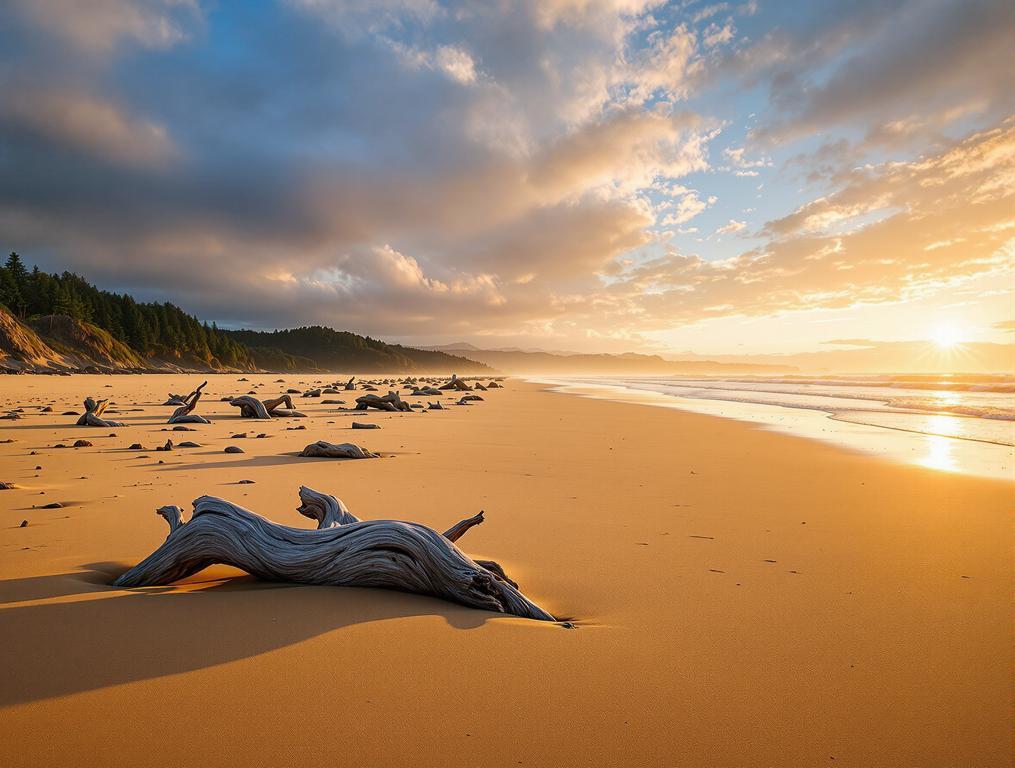I step out of my rental car into a warm June breeze that carries the scent of salt and pine. Before me stretches what appears to be an endless ribbon of sand disappearing into the horizon. This is Long Beach, Washington, home to America’s longest continuous sandy beach—28 miles of uninterrupted shoreline. It’s a Wednesday morning, and I count exactly seven people within eyesight on this vast expanse.
The tiny town of Long Beach (population 1,790) sits just 3 hours southwest of Seattle, yet feels worlds away from any metropolitan rush. I’ve visited beaches across America for over a decade, from the packed sands of Miami to California’s famous shores, but nothing prepared me for this peculiar combination of superlative scale and sublime emptiness.
America’s 28-Mile Beach Secret Hiding in Plain Sight
Long Beach’s shoreline stretches nearly three times longer than Santa Monica Beach in Los Angeles. The continuous sandy expanse runs from the mouth of the Columbia River to the tip of the Long Beach Peninsula, creating what locals proudly call the “World’s Longest Beach.”
What’s most striking isn’t just the length but the solitude. Unlike Florida’s Daytona Beach (23 miles) where umbrellas create colorful forests, here I find vast stretches where my footprints are the only human marks in the sand. It’s like having a national park-sized beach almost entirely to yourself.
The town’s tiny boardwalk offers elevated views of this natural wonder, with interpretive signs explaining how this geographic marvel formed. At the World Kite Museum nearby, displays showcase how the peninsula’s consistent winds have made this a kite-flying mecca for decades.
Summer 2025 marks a pivotal moment for Long Beach as eco-tourism trends shift travelers away from overcrowded destinations. Yet the annual International Kite Festival (scheduled for August 17-23, 2025) remains the only time when this beach feels remotely crowded—and even then, only in concentrated areas.
Longer Than Florida’s Famous Beaches, Yet Eerily Uncrowded
When comparing Long Beach to America’s famous coastal hotspots, the numbers tell a compelling story. While Miami Beach sees 7-10 million visitors annually, Long Beach Peninsula welcomes just over a million spread across its 28-mile expanse, creating a stark difference in experience.
The beach itself differs too. Unlike the manicured sands of southern destinations, Long Beach offers a wilder, more natural Pacific Northwest experience. Driftwood sculptures created by winter storms dot the landscape, while Discovery Trail provides a paved path for cyclists and walkers to explore the coastline.
“I’ve been to beaches all over the country, and this is the only place where I can walk for hours without seeing another soul. The space gives you room to breathe and think in a way that’s impossible at tourist beaches. Even in summer, it feels like a secret.”
For East Coast travelers, a similar hidden coastal gem awaits in Rhode Island, though nothing matches Long Beach’s remarkable scale.
The town itself embodies Pacific Northwest charm with weathered cedar buildings and seafood shacks serving fresh Willapa Bay oysters. Unlike oceanfront communities that have surrendered to high-rise developments, Long Beach maintains its small-town character—think Galicia, Spain rather than Myrtle Beach.
Where Beach Lovers Find Solitude During Peak Summer Season
The best way to experience this coastal wonder is via Highway 101, which provides multiple access points along the peninsula. Arrive on weekday mornings before 10 AM for prime beach access with minimal company, though even summer weekends rarely feel crowded.
While beach activities are the main draw, don’t miss the Cranberry Museum showcasing the region’s agricultural heritage, or continue your Washington exploration inland at this wine paradise for a complete Pacific Northwest experience.
Locals recommend exploring the Cape Disappointment Lighthouse at the peninsula’s southern tip, where dramatic waves crash against rocky bluffs in a scene reminiscent of Maine’s coastline. Festival lovers can also explore this Texas town’s celebrations for another small-community experience.
For wildlife enthusiasts, the Willapa National Wildlife Refuge offers glimpses of the region’s diverse ecosystem, including the spring and summer migration of shorebirds that use the beach as a critical stopover.
When to Visit and How to Experience This Natural Wonder
The optimal window for visiting runs May through September, with June offering the perfect balance of good weather and minimal crowds. July and August bring warmer temperatures (averaging 68°F) and slightly more visitors, though “crowded” here means something entirely different than at typical beach destinations.
Accommodation options range from charming bed and breakfasts in town to campgrounds that put you steps from the sand. Prices remain reasonable—another stark contrast to America’s famous beaches—with most hotels under $150/night even in peak season.
As I walk back to my car, the afternoon sun casts long shadows across rippled sand that seems to stretch infinitely. I think about beaches where finding a spot to lay your towel feels like a competitive sport, then look around at this enormous empty expanse.
Some places make you wonder how they’ve remained so perfectly preserved in an age of Instagram geotags and viral travel lists. Long Beach is that rare American treasure—hiding in plain sight, just waiting for those who value space and natural beauty over amenities and crowds.
